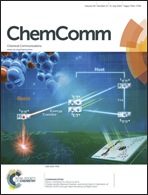Highly efficient Mo2C nanotubes as a counter electrode catalyst for organic redox shuttles in dye-sensitized solar cells†
Abstract
Molybdenum carbide nanotubes (Mo2C-NTs) were synthesized and showed remarkable catalytic activity for regeneration of an organic sulfide redox shuttle. The dye-sensitized solar cells (DSCs) using Mo2C-NTs as the counter electrode (CE) showed a high power conversion efficiency of 6.22%, which is much higher than the DSCs using a conventional Pt CE (3.91%).


 Please wait while we load your content...
Please wait while we load your content...